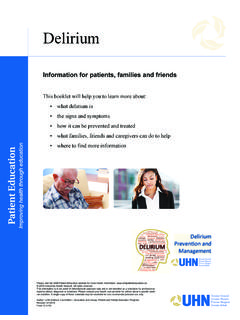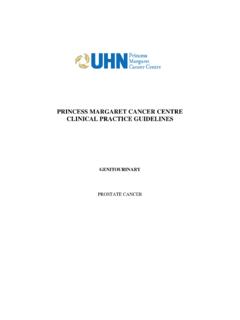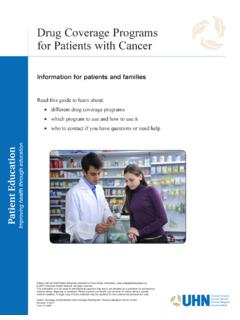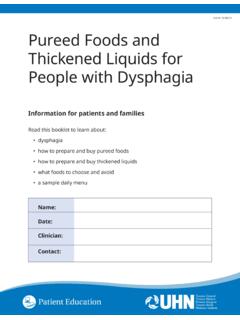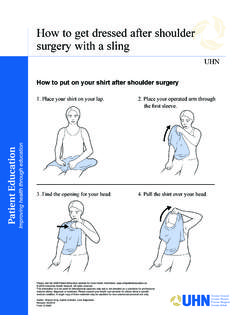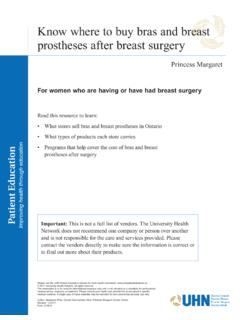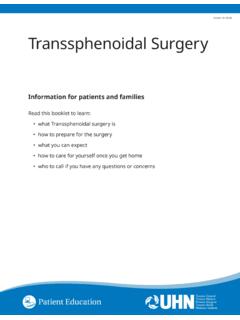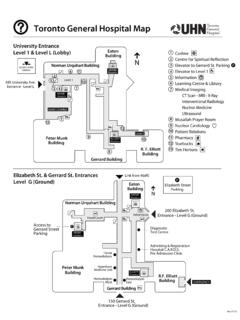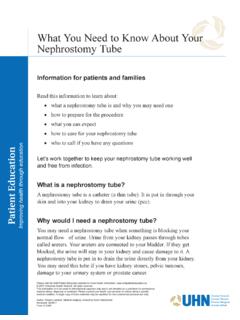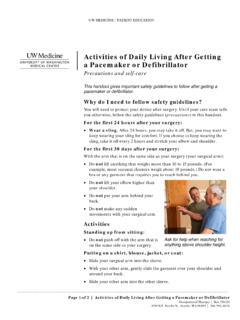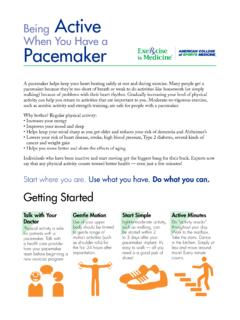Transcription of Going Home After Getting a Pacemaker or Defibrillator
1 Going Home After Getting a Pacemaker or DefibrillatorInformation for patients and familiesRead this booklet to learn how to care for yourself when you return home and who to call if you have any are Going home with: a new Pacemaker (PPM) a new Defibrillator (ICD) an implantable loop recorder (ILR) a biventricular Defibrillator (CRT-D) a pulse generator replacement (PGR or battery replacement) a lead repositioned a new lead a pocket revision an explanted Pacemaker a laser lead extractionForm: D-51002 When can I shower?You can take a bath or a shower 48 hours After you get home, but your incision (the cut from your procedure) site must stay dry for 5 to 7 you bathe or shower, tape a piece of plastic bag or plastic wrap over your dressing to keep your incision dry.
2 You can remove the plastic and dressing After your bath or shower. Then change your do I change my dressing?It s important to keep your incision (cut) clean and dry. This will help keep it from becoming infected. It will also help it heal well. We will give you what you need to use to change your dressing your dressing once a day for 5 to 7 these instructions for changing your dressing:Step 1 Collect the things you will need for your dressing change. You will need: 1 Medipore Plus pad 3 alcohol-free or 2% chlorhexidine swabs You received these supplies from the 2 Wash your hands for 30 seconds with soap and water.
3 Pat your hands dry with a clean towel. 3 Step 3 Remove your old dressing. Check your incision site in front of the mirror. Call your family doctor or the Pacemaker / Defibrillator Clinic if you have any of these signs of infection: redness swelling a fever over 38 C or 101 F your incision has opened pus (yellowish green liquid) is oozing from your incisionStep 4 Wash your hands again with soap and water. Pat them dry with a clean towel. Step 5 Use the first swab to clean along the incision.
4 Use 1 side first and then repeat using the other side of the swab. Throw away the first swab. If you have steri-strips over your incision, clean them with the swab. If they are falling off, just remove them. 4 Step 6 Use the second swab to clean above your incision. Use the other side of it to repeat if necessary (if it does not look clean yet). Throw away the second 7 Use the third swab to clean below your incision. Use the other side of it to repeat if necessary.
5 Throw away the 3rd swab. Step 8 Cover your incision with the Medipore Plus pad and press down gently to keep it in 9 Wash your hands again with soap and water. Pat them dry with a clean towel. What if I have stitches?You may or may not have stitches. If you have stitches, you will see them on your incision. Make an appointment with your family doctor 7 to 10 days After your procedure. Your doctor will check your site and remove the stitches at this time. Most people don t have stitches that need to be removed.
6 If you have steri-strips, they can be showered off After 7 days or peeled off activities can I do when I get home?For 4 weeks After your new Pacemaker , new Defibrillator , new lead, or change in position of your lead, DO NOT: reach for things that are above your head lift anything heavier than 10 pounds (5 kilograms) After 4 weeks you can begin to do the activities you did before the hours After you get home:Start doing gentle exercises with your arm to keep your shoulder from becoming too stiff. You can do these exercises 3 to 4 times each day: Slowly walk your fingers (on the side you had the procedure) up a wall until they reach your shoulder height.
7 Walk them back down. Repeat 4 to 5 times. Pretend to play the piano. Make sure you cover all the keys. Do gentle circles with your shoulders by rolling them forward and backward 2 to 3 times can I drive?Talk to your doctor or advanced practice nurse (APN) about when you can drive kind of follow-up care will I need?You will need regular follow-ups After Getting your Pacemaker / Defibrillator . Your first appointment is usually 8 to 10 weeks After your procedure. You will get an appointment for this follow-up before you are discharged call the Pacemaker / Defibrillator Clinic 24 hours before your appointment if you need to cancel or : 416 340 3248 You need to bring a list of all the medicines you are taking, including information about how much and how often you are taking them.
8 You can also bring all your medicines (in their original bottles) with you to your appointment for Defibrillator patients: If you had one shock from your Defibrillator and you are feeling OK, call the clinic to let them know. If you are worried, you can go to your local emergency department to be 911 if you: are feeling short of breath are having chest pain are feeling faint or like you are Going to faint had one shock from your Defibrillator and you are feeling sick had more than 1 shock from your Defibrillator in 24 hoursIf you are worried about your medicines, blood pressure or other heart problems, tell your family doctor or your cardiologist.
9 They can follow-up with do I need to do now that I have a Pacemaker or Defibrillator ? You should wear a Medic Alert bracelet to let others know about your Pacemaker or Defibrillator . To register for one, you can visit the website or ask at the nurse s station for an application. You can also fill out an application at your local pharmacy. Carry a list of the medicines you are taking with you at all times. Show them to your family doctor and cardiologist. We gave you some important information about your Pacemaker or Defibrillator . Keep it in a safe place where you can easily find it: Always keep your Pacemaker / Defibrillator identification card in your wallet.
10 You got a temporary card at the hospital, but you will get a permanent card in the mail. The card has the name of the company who made it and the type of Pacemaker / Defibrillator you have printed on it. You also got a print out of your Pacemaker or Defibrillator setting. This print out includes important information about the rate and how it is can I call if I have any questions?We look forward to helping with your care. If you have any questions or concerns about your Pacemaker or Defibrillator , please call: Pacemaker / Defibrillator ClinicToronto General HospitalGerrard Wing 3rd floorPhone: 416 340 3248 Office hours: 8:30 am to 4:30 pmLeave a message After hours and we will return your call as soon as we can also call your cardiologist or.
